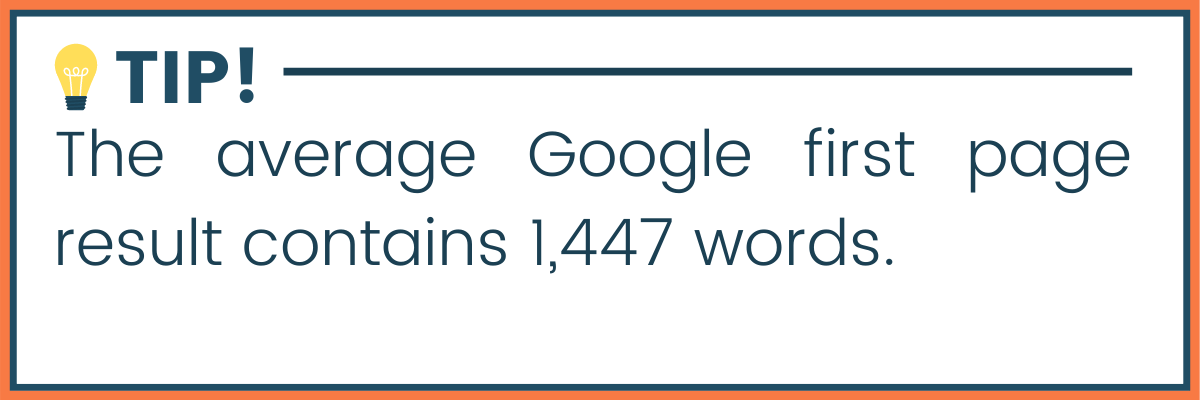How To Write Blog Posts for SEO That Actually Help Your Website Perform

As a blogger, search engine optimization should be a priority. It's a fundamental way of making sure your website ranks higher on search engine results pages (SERPs).
But how exactly do you write blog posts for SEO? Despite what many people think, it doesn't have to be time-consuming or super technical.
When it comes to optimizing your blog posts for SEO, there are some guidelines on what you should do and shouldn't do.
Strategy is key.
Ever received a free audit of your website? We provide one and it's no sales pitch, it's strictly educational.
This article will share some tips for writing SEO-optimized articles that will rank high on Google and show up in the results for every relevant search.
1. Think Before You Start Writing
Blog writing requires forethought and structure. Gather your thoughts before you jump and start writing.
You'll want to take this time to consider the type of content that resonates with your audience and that which is powerful at showcasing your authority in your specific niche.
What central question would you like to answer? What's the purpose of the article? What useful information will be found in the post? Is there something specific you would want your readers to do at the end of the page?
Having the answer to these questions in advance makes it easier to move on to the next steps.
2. Devise a Structure for Your Blog Post
A good blog post should have an introduction, the main section and a conclusion. When writing a blog post, create an outline that includes the primary points of your blog post, your sub-points, your call to action and extra links you would want to add.
Having an outline will help you stay focused on the purpose of the post and create a flow that moves seamlessly from one point to the next.
Use Headings to Your Benefit
Headings not only structure your content, but they are also crucial for SEO. Headings help search engines grasp the main topics of a long post which in turn will improve your blog post ranking.
A well-optimized blog post will follow these rules when it comes to headings:
- Have only one h1 tag that includes your target keywords
- Use headings in a hierarchical mode - Using heading tags (H1, H2, H3 etc. is important for both SEO and making articles more visually appealing. H1 tag is a header, usually the title of the post. H2 is a subheader of the H1, usually plans out sections. An H3 is a subheader of the H2 covering specific topics, and so on.
3. Craft the title and URL
Your blog post's title is essential for search rankings. It's the first component in determining the relevance of your content so make sure you craft a title that is optimized for your target keyword.
Content is vitally important for search engine optimization. Learn the basics of a content marketing strategy for your business.
To make your blog post title more SEO friendly, it should include the following:
- A long-tail keyword
- Have 20-60 characters (To ensure you're not cutting important words off in search results.)
- Give the reader a clear idea of what the article is about (should describe what the post will be about.)
- Be interesting and catchy
On the other hand, according to Backlinko, short URLs tend to have a slight ranking advantage over longer URLs. This is because shorter and cleaner URLs provide a better user experience and are more easily understood by Googlebot.
For the most SEO-friendly URLs, keep it between 50-80 characters (including your target keyword phrase.)
We recommend using Moz's title tag preview tool to see what will be visible to users and what will be cut out as Google cuts off the title based on pixel count.
4. Plan Your Content Based on Keyword Research
You don't need to rely on blind guesses when planning your content strategy. The foundation of any successful SEO campaign is keyword research.
By targeting the right keywords, Google and other search engines can effectively drive organic traffic to your content. Google comes to associate your website with certain search terms.
Before you start writing, you have to do keyword research. Google Keyword Planner and SEMrush are both great for this.
Learn even more about how to conduct keyword research to find opportunities for your business in this video.
Such tools generate a list of keywords that are closely related to your main keyword, which you can then mention in your blog post. When picking your focus keyword, go for one that has the highest search volume and low competition.
The power of keyword research lies in better understanding of your target audience and how they search for your content, services, or products.
By figuring out which words your audience searches for, you'll know which words to use in your text and the topics to write about to ensure that you're writing about topics that people are actually searching for.
Use of Long Tail Keywords
The most obvious keywords aren't always the best keywords. Usually, most searchers are inclined to use specific long-tail keyword phrases and questions when they are looking for something online - Long-tail keywords account for up to 70% of all search traffic.
According to Internet Live Stats, Google receives over 75,000 individual searches every second. Because of the vastness of the search, it's easier to find the audience for your particular niche by focusing on a group of long-tail keywords.
Avoid Keyword Stuffing
There's no need to stuff your keyword multiple times on a page. A post that mentions "best coffee shop in Kent" every other line is not going to be easy to read. This can do more harm than good as your post will look "spammy" to search engines, hurting your chances of ranking well.
Instead, place your keyword (or keyword phrase) and keyword variations naturally where they will have the most impact for search engine crawlers indexing your content like in the:
- Title of the post
- Main heading
- Meta descriptions
- Within the content of the post and in the conclusion
5. Optimize Your Images
Google Image Search can send a lot of traffic to your blog if you optimize your images properly.
For any image you add to your post, you'll want to add alt text which is a closed caption for images that describes what's happening in the photo.
By having an appropriate alt text, Google can recognize what the image is all about, and this may help serve the page for suitable search queries. A well-thought-out image alt description is also vital if you want to rank in Google Images.
Besides adding alt text, make sure your images are placed in a proper relevant context, as well. Large photos are a leading culprit of page lag.
To keep your posts visually interesting without sacrificing crucial speed, consider using a WordPress plugin called ShortPixel, which compresses your images, making them load faster.
Use Google's PageSpeed Insights test to find out how well your images are optimized.
6. Short Paragraphs
Short and easily digestible paragraphs ensure readers remain engaged and help them cruise through your content easily. So, ensure you break your content into bite-sized paragraphs for easy readability (about 2-5 sentences long).
There are high chances that the majority of your readers are on a mobile device, so it's imperative to make it easy for them to read the content.
Each new paragraph should present its own idea or subject. You can also incorporate images, videos, or other media elements to make the content more interesting and valuable.
Also, remember to use different formatting options, i.e. bullets, numbered lists, blockquotes, bold, italic and underline to break up a block of text or to emphasize a particularly important point.
6. Commit to a Good Link Building Strategy
Links are a major ranking factor for Google and all major search engines.
Sites with more backlinks tend to earn higher rankings as it's a signal to Google that your site is a quality resource worthy of citation.
Your aim as a blogger should be to engage in natural link building rather than achieving them through manipulative tactics (also known as black-hat SEO), a practice that can get your site essentially pulled from the search results.
Chances are you've already written content on the same topic as your current post. With internal linking, you can link these posts together and send new readers to check out your older relevant posts.
Linking back to your own service page is a best practice that helps your audience discover more of your content and get to know you as a high authority, credible source of information. It also keeps them on your website and increases your chances of making a sale.
When it comes to adding links, place them as hyperlinks around a phrase or word, if possible, rather than just placing the page URL on the blog post. Other linking strategies to get external websites to link to yours include:
- Guest posting on relevant and more authoritative sites
- Contacting other bloggers or influencers in your niche with a large social media following and introducing your website and content
- Linking to other websites from your content and contacting them to let them know. If they find your website useful, they may opt to do the same for you.
Word of Caution:
Don't overdo your internal linking or any linking. While it's tempting to link to all of your blogs and webpages, it's more rewarding to choose the links that naturally tie in with the subject matter or best enhance the point or insight you're writing about. Further, never link to an insecure or spammy website as this could have a negative impact on SEO.
7. Optimize the Length of Your Blog Post
You probably didn't know this, but the length of your blog posts makes a difference to your visibility.
Not convinced yet?
According to Codeless, longer in-depth blog posts generate 9x more leads than short ones. This is because longer blog posts will likely have multiple keywords sprinkled throughout the content, meaning they have a greater chance at ranking.
Additionally, long blog posts tend to be more detailed, which improves audience engagement and generates more social shares.

Most bloggers are also more than willing to provide backlinks to such blog posts. But there is a catch here. Always ensure that you provide well-researched, statistically enriched and comprehensive blog posts to enjoy the full SEO benefits of long-form content.
8. Optimize Your Meta Description
Are you adding meta descriptions to your post? If the answer is no, then you might be missing out on a great way to increase click-throughs and polish your brand SERPs boost rankings.
Just as headers and target keywords communicate with Google, a good meta description entices people to read your post by clarifying what the page is about.
Meta descriptions are the 1-3 sentence descriptions you'll find underneath the title of a result. Include your most significant keywords and give each page a unique description that clearly reflects what value the page carries.
9. Add Content Regularly
As you consistently create high-quality and engaging content, the page will be indexed more often, increasing the chances of getting a higher ranking. This is why a serious blogger needs to prioritize consistency.
Whatever your blogging frequency, make sure you maintain a consistent posting schedule so that even your audience knows when to hear from you.
Hopefully, you've learnt some invaluable tips so you can start creating SEO-friendly blog posts that make a significant difference in your ability to drive value from your blogging efforts.
Contact Us for Advanced SEO Techniques That Drive Results
Agency Jet is a digital marketing agency that offers website design and SEO digital marketing packages designed to help you gain a competitive edge in search results on Google, Bing, and other search engines.
Be sure to view all the SEO services we offer to see what you can expect with this digital marketing service!
More Resources
| READ: What Aspects of a Hyperlink are Not Important for SEO | VIDEO: Business Actions in Times of Crisis |
| VIEW: Agency Jet case studies | READ: 6 Mistakes to Avoid to Help You Understand SEO in MN |


